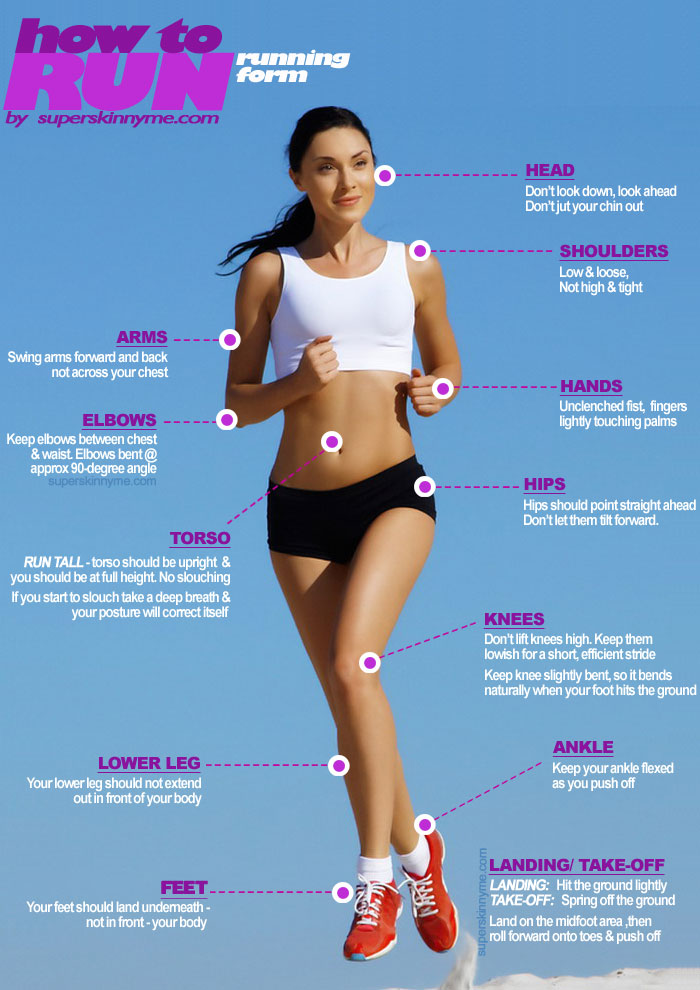When people think about how to run, they tend to focus on the feet. However, proper running form starts with the head and works its way down to the feet. If your head and upper body are aligned properly, your lower body and your stride are more likely to be correct.
So, why is running form important? Running form matters for two reasons, it helps you to not get hurt and to run using as little energy as possible so that running take less effort and feels easier. In other words, you tire less easily and protect against injury.
What is Proper Running Form?
Perhaps an easy way to describe how to run is to “run tall”; which means you should stretch yourself to your full height, with your back fairly upright.
Below is a little more info on how to run tall. Don’t feel overwhelmed. These pointers are not there to help you run, they’re just there to help you run better.
1 Head
Good head alignment is key to good running form. Look ahead towards the horizon, neither up nor down. This will straighten your neck and back, bringing them into alignment. Your jaw and neck should be relaxed and your chin should not jut out.
2 Shoulders
Keep your shoulders square, low, loose and relaxed. While you’re running your shoulders should remain square and level. They shouldn’t be swaying from side to side. No slouching.
Don’t allow your shoulders to move upwards and become high and tight. If you feel your shoulders getting tense, shake them out and release the tension.
3 Torso
With your head and shoulders aligned correctly, your torso should be in the right position.
Your torso should be almost straight, such that you’re running in an upright position, but leaning ever so slightly forward creating a completely balanced posture.
Avoid: Don’t lean back and do not hunch over. Leaning too far forward produces a stumbling, high-impact stride, placing excessive stress on the knees and back. Leaning backward will cause you to take overly long strides and land heavily on your heels, stressing the knees, hips and back. Also, avoid twisting your torso from side to side.
Running upright, with your shoulders back, opens up your chest for maximum lung capacity allowing you to breathe more easily.
4 Arms
Your arm movement matters, as it helps propel you forward during running making you run faster. Your arm movement also helps to minimize rotation of the torso.
Keep your elbows bent at an approximately 90 degree angle. Your arms should be relaxed and move in concert with your leg stride.
Arm swing:
- Swing your arms up and down.
- During the upward swing bring your hands in and up towards your sternum.
- During the downward swing bring your hands out and down towards your waistband.
- Keep your movement moderate, don’t swing your arms too high or too low, ie keep your arms between waist and chest level.
- While your arms should swing in and out a little, they should not swing across your body. Most of your arms movement should be forwards and backwards.
Hands: Keep your hands and wrist relaxed, with your hands in an unclenched fist. Your fingers should lightly touch your hands.
5 Hips
Positioning your hips is not so easy to get your head round. But really all it is, is that your hips should point straight ahead.
Your hips should be positioned correctly if your head, shoulders and torso are properly aligned. If your torso is leaning too far forward or leaning backward, it will also tilt your pelvis and push your body out of alignment.
6 Legs + Knees
In endurance running the knees are not lifted high. Knees are kept fairly low and feet relatively close to the ground to create an energy efficient stride. Lifting the knee high, as in sprinting, requires a lot of energy and is mostly done to create power and speed.
Keep knees slightly bent to absorb the impact when you hit the ground. Don’t make too long a stride, but aim for your feet to land underneath your body. If your lower leg extends in front of your body, you’re taking too long a stride. Running tall with a low knee lift will help stop overstriding.
7 Feet
Your foot should hit the ground lightly. Landing on the midfoot area is believed to be more optimal, and then quickly rolling your foot forward onto the ball of the foot/ toes and springing off the ground. Ideally your landing should be light, soft, and quick, not hard and thumping.
However, everyone’s gait and foot strike is slightly different, and why it’s important to get running shoes suited to your running style.
The more you run, the more you’ll understand the guidance and put it into practice. Don’t read this and feel you have to understand and do everything exactly right in order to run. Keep the main thing, the main thing. Just get out and run, the rest will follow. If you simply run tall, you’ll be doing most things right already. So, don’t worry!
Read more: Beginner running plan



Well, my legs are superhuge, in wich EVERYTHING is muscles. I look so ugly in a dress and in shorts, would someone please tell me what to do about it, what exercise/es should I do to slim down?
I wish I look that good while running!
Great article! I love the visual…thank you!